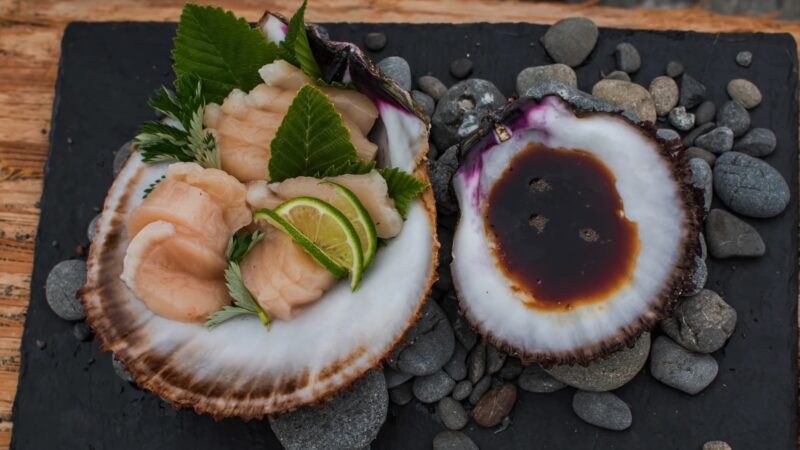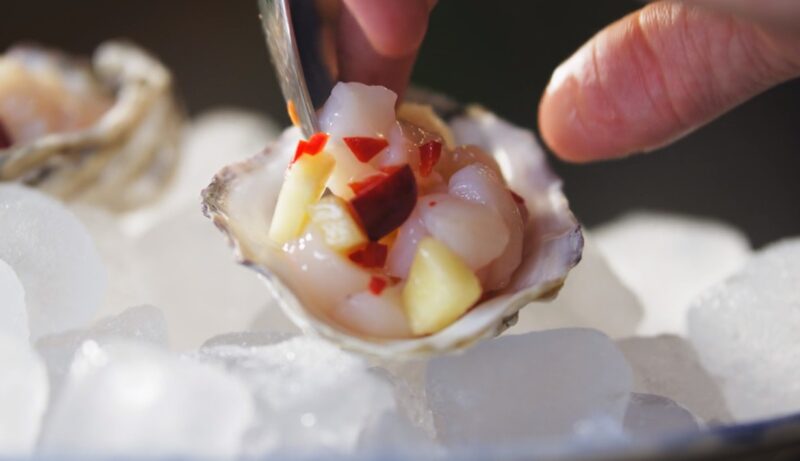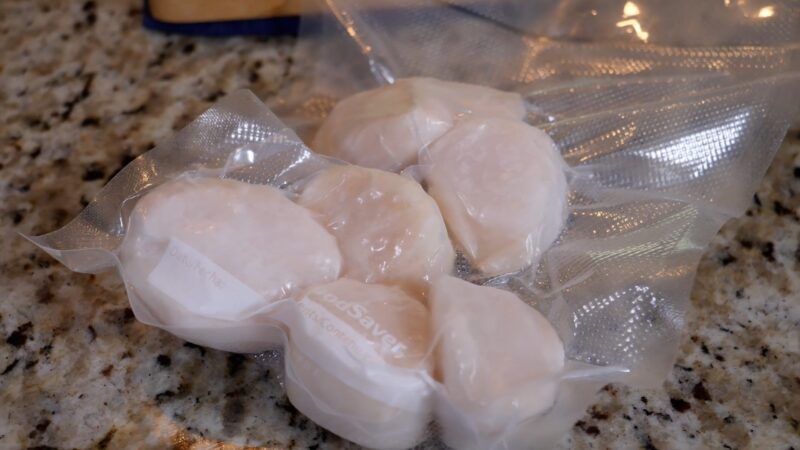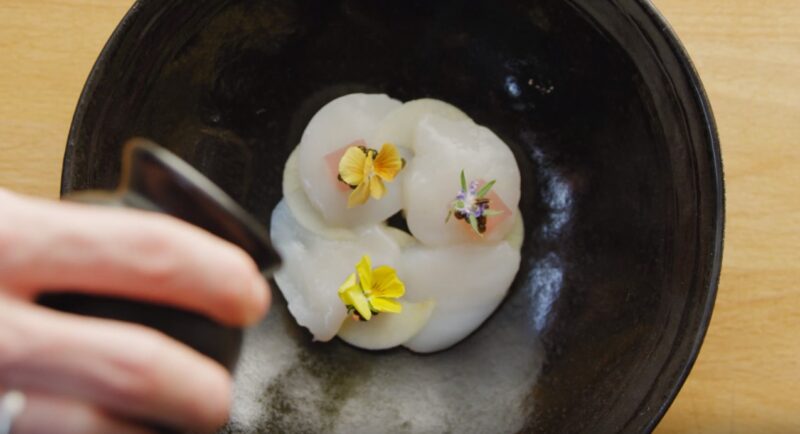Scallops, a cherished seafood delicacy, are often enjoyed cooked, but there’s a growing interest in consuming them raw. This trend raises questions about safety, nutritional value, and preparation methods.
Scallops are bivalve mollusks, similar to clams and oysters, and are known for their distinctive, fan-shaped shells and the sweet, tender meat residing within. This type of food is not only good for its taste but also because they are a low-fat source of protein and are rich in vitamins and minerals such as vitamin B12, magnesium, and potassium.
This nutritional profile makes them a healthy addition to various diets. When it comes to eating them raw, safety is a essential. Freshness is key, as scallops can harbor harmful bacteria and toxins if not handled correctly. It’s crucial to source scallops from reputable suppliers and ensure they are fresh and properly refrigerated.
Benefits of Eating Raw Scallops

Eating raw scallops offers several health benefits. They are an excellent source of lean protein, essential for muscle building and repair. The high levels of omega-3 fatty acids in scallops contribute to heart health and may reduce inflammation. Additionally, the presence of antioxidants like selenium in scallops supports immune function.
Are There Potential Health Risks?
However, consuming raw scallops is not without risks. The primary concern is the potential presence of pathogens like Vibrio bacteria, which can cause foodborne illnesses. People with compromised immune systems, pregnant women, and young children should avoid eating raw scallops. It’s also crucial to be aware of the risk of shellfish allergies, which can be severe.
How To Prepare Raw Scallops?

Choosing the right scallops for raw consumption is vital. Look for “sashimi-grade” or “sushi-grade” labels, which indicate they are safe to eat raw. The scallops should have a fresh, mild ocean scent and a moist, not slimy, texture. When preparing, it’s essential to maintain cleanliness to avoid cross-contamination.
Serving Suggestions
Raw scallops can be served in various ways. They can be thinly sliced and served as carpaccio or ceviche, where they are “cooked” in an acidic marinade. Another popular option is serving them as sashimi, complemented with soy sauce, wasabi, and pickled ginger. The delicate flavor of raw scallops pairs well with light, acidic dressings and fresh herbs.
Health and Safety
While the health benefits are notable, it’s crucial to understand the risks associated with consuming raw seafood. Pathogens, if present, can lead to severe illnesses. To mitigate these risks, strict adherence to food safety standards is essential.
This includes proper refrigeration, handling, and thorough inspection of the seafood before consumption. Being informed about the source and handling of their seafood is crucial. Asking questions about the origin, storage, and preparation methods when dining out or purchasing for home consumption can provide valuable insights into the safety of the dish.
Best Recipes
The proper preparation of raw seafood will require various spices and other add-ons. Here are the most popular options.
| Recipe Name | Ingredients | Preparation Method | Serving Suggestion |
|---|---|---|---|
| Scallop Ceviche | Fresh scallops, lime juice, red onion, cilantro, jalapeño, avocado, salt, pepper | Marinate scallops in lime juice with finely chopped onion, cilantro, and jalapeño. Chill for 1-2 hours. | Serve chilled with avocado slices and tortilla chips. |
| Scallop Carpaccio | Fresh scallops, lemon juice, olive oil, capers, arugula, Parmesan cheese, salt, pepper | Thinly slice scallops, drizzle with lemon juice and olive oil. Garnish with capers, arugula, and Parmesan shavings. | Arrange on a plate, season to taste. |
| Scallop Sashimi | Fresh scallops, soy sauce, wasabi, pickled ginger | Slice scallops into thin pieces. Serve with soy sauce, a dab of wasabi, and pickled ginger on the side. | Present on a sashimi plate for a traditional experience. |
| Scallop Tartare | Fresh scallops, chives, lemon zest, olive oil, avocado, Dijon mustard, salt, pepper | Finely dice scallops, mix with lemon zest, olive oil, mustard, chives, salt, and pepper. | Serve atop avocado slices or with crostini. |
| Scallop and Mango Ceviche | Fresh scallops, mango, lime juice, red bell pepper, red onion, cilantro, jalapeño, salt | Combine diced scallops and mango with lime juice, finely chopped bell pepper, onion, cilantro, and jalapeño. | Serve chilled, garnished with cilantro leaves. |
Raw vs Processed Scallops – What is the Difference?
The choice between raw and processed scallops can significantly influence the flavor, texture, and overall outcome of a dish. This decision is often guided by the intended recipe, cooking method, and desired taste profile.
Raw scallops are known for their fresh, sweet, and delicate flavor. This natural taste is a result of their direct harvest from the sea, without undergoing any processing or cooking. The freshness is a critical factor in their quality and taste.
Processed scallops are typically categorized as either ‘dry’ or ‘wet’. Dry scallops are shucked and immediately frozen with no additives, preserving their natural flavor and texture. Wet scallops, on the other hand, are treated with sodium tripolyphosphate (STP) or similar chemicals to extend shelf life and add weight, which often leads to a slightly altered taste and texture.
Nutritional Comparison
Both raw and processed scallops are nutritious, offering high protein, low fat, and a good source of minerals like magnesium and potassium. However, the nutritional value can be slightly affected in processed varieties, especially wet scallops, due to the added chemicals and water content.
The processing of scallops, especially in the case of wet scallops, raises questions about environmental impact and ethical practices. The chemicals used can have implications for both health and the environment, making it crucial to choose scallops processed with minimal impact methods.
| Nutrient | Raw (per 100g) | Processed (per 100g) |
|---|---|---|
| Calories | 88 kcal | Varies (approx. 100-115 kcal) |
| Protein | 16.8 g | Varies (approx. 14-20 g) |
| Total Fat | 0.8 g | Varies (approx. 0.5-2 g) |
| Carbohydrates | 3.2 g | Varies (approx. 3-5 g) |
| Cholesterol | 33 mg | Varies (approx. 30-40 mg) |
| Sodium | 111 mg | Varies (higher in wet scallops due to additives) |
| Magnesium | 55 mg | Similar to raw |
| Potassium | 314 mg | Similar to raw |
Can it Be Dangerous To Eat Raw Scallops and How to Avoid Issues?

One of the primary concerns with raw scallops is bacterial contamination. Pathogens like Vibrio, Salmonella, and E. coli can be present in scallops harvested from polluted waters. Consuming contaminated scallops can lead to foodborne illnesses, with symptoms ranging from mild gastrointestinal distress to severe dehydration and, in rare cases, even death.
In addition to bacteria, raw scallops can harbor parasites and viruses. While less common, these can cause serious health issues. Proper handling and sourcing from clean, uncontaminated waters are essential to minimize this risk. Safety Practices The first step in ensuring safety is to purchase scallops from reputable suppliers. These suppliers should adhere to strict standards for harvesting and handling seafood.
Scallops labeled as “sashimi-grade” or “sushi-grade” have undergone rigorous selection processes to ensure they are safe for raw consumption. Once purchased, scallops should be stored at the right temperature. They should be kept refrigerated and consumed as soon as possible. Cross-contamination with other foods, especially raw meats, should be avoided.
Fresh scallops have a mild, sweet smell and a moist, not slimy, texture. Any signs of spoilage, such as a strong fishy odor or discoloration, indicate that the scallops are not safe to eat raw.
Special Considerations
Certain groups, including pregnant women, young children, the elderly, and individuals with compromised immune systems, should avoid eating raw scallops. For these groups, the risks associated with raw seafood consumption are significantly higher.
Shellfish allergies are another important consideration. Individuals with a known allergy to shellfish should avoid scallops, both raw and cooked, as allergic reactions can be severe.
FAQs
Can lemon juice or vinegar ‘cook’ raw scallops, making them safer to eat?
Lemon juice or vinegar can change the texture of raw scallops, making them appear ‘cooked’ as in ceviche, but it does not eliminate all harmful bacteria or parasites. It’s a culinary technique that alters texture and flavor, not a safety measure.
How long can you keep raw scallops in the fridge before they become unsafe to eat?
Raw scallops should ideally be eaten within 1-2 days of purchase when stored in the refrigerator. Beyond this period, the risk of bacterial growth increases.
Are there any specific seasons when eating raw scallops is safer?
Eating raw scallops is generally safer during colder months, as warmer temperatures can increase bacterial growth. However, sourcing from reputable suppliers and ensuring proper handling is crucial year-round.
Can freezing scallops make them safe for raw consumption?

Freezing can kill some parasites present in scallops, making them safer for raw consumption. However, it does not eliminate all pathogens, so proper sourcing and handling are still important.
Can people with shellfish allergies eat scallops if they are cooked?
People with shellfish allergies should avoid scallops, both raw and cooked, as cooking does not eliminate the allergens present in shellfish.
Summary
Eating raw seafood, particularly bivalves, is an experience that balances flavor, texture, nutrition, and artistry. While it offers a unique and enjoyable culinary adventure, it also requires careful consideration of health, safety, and sustainability.
By understanding these aspects and making informed choices, enthusiasts can fully appreciate the delicacy and sophistication of raw seafood dishes.
